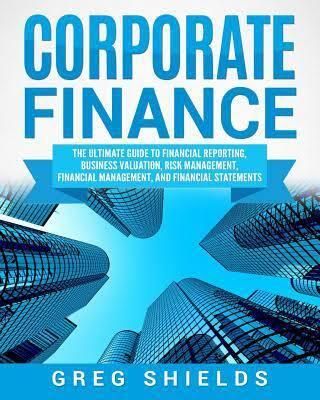Corporate Finance
Review Corporate Finance: The Ultimate Guide to Financial Reporting, Business Valuation, Risk Management, Financial Management, and Financial Statements
by GRED SHIELDS
Description
Author Greg Shields’ “Corporate Finance: The Ultimate Guide to Financial Reporting, Business Valuation, Risk Management, Financial Management, and Financial Statements,” holds a 5-part textbook and reference bundle that fully explains corporate finance. While it may not fully be equipped as reference material for large-scale accountants or risk managers, “Corporate Finance” does help those who are looking into investing and running a corporation.
About the Author
Greg works as a director for the Auditing and Assurance Standards at Chartered Professional Accountants of Canada (CPA Canada). He supports the activities of the Canadian Auditing and Assurance Standards Board.
Table of Contents
- An introduction to corporate finance
- Part 1: Financial Reporting
- Introduction
- Breaking down the basics
- Summary of the four main financial documents
- Internal vs. external financial reporting
- How to assess a financial report as a whole
- Footnotes: What they are and why they are important
- How to create and analyze a financial report
- What is included in the footnotes
- What programs are there to help you create a financial report
- Securities and Exchange Commission (SEC)
- Quarterly and Annual Reports for Stockholder
- Press Releases and Conference Calls; why are they important?
- Conclusion
- Part 2: Business Valuation
- Introduction
- Chapter 1 – Why you might need a business valuation
- Chapter – The Basic Concepts behind Business Valuation
- Chapter 3 – Profit based approaches
- Chapter 4 Revenues based approaches
- Chapter 5 – Asset-based approaches
- Chapter 6 – Discounted cash flow
- Chapter 7 – Sector-specific approaches
- Chapter 8 – Valuing intangible assets
- Chapter 9 – As art, not a science
- Chapter 10 – What to look for in financial statements
- Chapter 11 – Buying or selling
- Conclusion
- Part 3: Risk Management
- Introduction
- Chapter 1 – The Benefits of Risk Management
- Chapter 2 – The Basic Concepts and Vocabulary of Risk Management
- Chapter 3 – Enterprise Risk Management
- Chapter 4 – Risk Management Models and the ‘The Greeks’
- Chapter 5 – Credit Risk Management
- Chapter 6 – Some aspects of market risk management
- Chapter 7 – Operational risk management
- Chapter 9 – Managing assets and portfolios
- Chapter 10 – Losses and limits
- Chapter 11 – Instruments for managing risk
- Conclusion
- Part 4: Financial Management
- Introduction
- Chapter 1 – What is financial management and why do you need it?
- Chapter 2 – Financial statements
- Chapter 3 – Looking at cash flow
- Chapter 4 – Forecasting, budgeting, and flex
- Chapter 5 – Capital spending and discounted cash flow analysis
- Chapter 6 – Some aspects of treasury management
- Chapter 7 – Managing your working capital
- Chapter 8 – Hedging your bets
- Chapter 9 – Management accounting
- Chapter 10 – Ratios – Your management dashboard
- Chapter 11 – A quick look at risk management
- Conclusion
- Part 5: Financial statements
- Introduction
- Chapter 1 – Accounts and Audit
- Chapter 2 – The profits and loss account
- Chapter 3 – The balance sheet
- Chapter 4 – Sources and the use of funds
- Chapter 5 – Notes to the accounts
- Chapter 6 – Running the ratios
- Chapter 7 – Putting it into practice – Sears
- Chapter 8 – Putting it into practice – Airbus
- Chapter 9 – Depreciation and amortization – A closer look
- Chapter 10 – A few tips for the business owner or manager
- Chapter 11 – Quality of earnings
- Conclusion
- Resources / Sources of Information – Financial Statements
- Check out more books by Greg Shields
- Resources / Sources of Information
